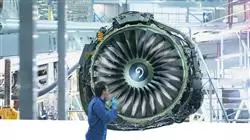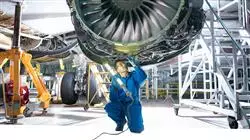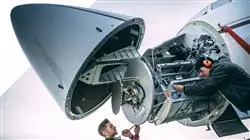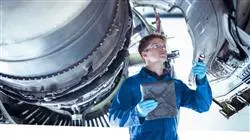University certificate
Scientific endorser

The world's largest faculty of engineering”
Introduction to the Program
Enroll now in a university program that responds to your professional motivations and growth in the aviation sector"

From the reduction of greenhouse gas emissions, the improvement of safety measures, to the technological development of unmanned aircraft and their integration into the airspace make up the great challenges of the aeronautical sector.
For this reason, the professional engineers who wishes to prosper in this industry must have a global knowledge of its operation, as well as specialized knowledge of the elements of manufacturing, design and commissioning of both aircraft and airports. A complete knowledge that will be much easier to acquire thanks to this Professional master’s degree in Aeronautical Engineering created by this institution.
An intensive program that consists of a syllabus that has been prepared by an excellent team of professionals dedicated to this industry. Their technical and teaching experience is reflected in a syllabus that covers technological innovations and aeronautical operations, deepens in the main actors of the sector, continued airworthiness, comprehensive sustainability and the entire international regulatory framework.
Students will obtain this learning through advanced content, complemented by video summaries of each topic, detailed videos, specialized readings and simulations of case studies that can be accessed comfortably, whenever and wherever they wish.
To take this program, the graduates only needs a digital device with an Internet connection to visualize, at any time of the day, the syllabus hosted on the virtual platform. A unparalleled academic option that only TECH, the world's largest digital university, can offer.
A 12-month Professional master’s degree in Aeronautical Engineering that adapts to your schedule"
This Professional master’s degree in Aeronautical Engineering contains the most complete and up-to-date program on the market. The most important features include:
- Development of case studies presented by experts in Aeronautical engineering
- Graphic, schematic, and practical contents with which they are created, provide scientific and practical information on the disciplines that are essential for professional practice
- Practical exercises where self-assessment can be used to improve learning
- Its special emphasis on innovative methodologies
- Theoretical lessons, questions to the expert, debate forums on controversial topics, and individual reflection assignments
- Content that is accessible from any fixed or portable device with an Internet connection
Thanks to the Relearning system, you will acquire an effective learning experience far from the long hours of study. Enroll now”
The program’s teaching staff includes professionals from sector who contribute their work experience to this educational program, as well as renowned specialists from leading societies and prestigious universities.
Its multimedia content, developed with the latest educational technology, will provide the professionals with situated and contextual learning, i.e., a simulated environment that will provide an immersive education programmed to learn in real situations.
The design of this program focuses on Problem-Based Learning, by means of which the professionals must try to solve the different professional practice situations that are presented throughout the academic course. This will be done with the help of an innovative system of interactive videos made by renowned experts.
The case studies will allow you to obtain a real analysis of the regulations in which the main actors of air transport operate"

With this university program you will be up to date in the measures applied for the efficiency and reduction of acoustic and gaseous emissions in aviation"
Syllabus
The syllabus of this Professional master’s degree has been designed to offer the engineering professionals the latest advances in the field of aviation. Innovation in the technological field, sustainability, manufacturing or regulation will be addressed throughout the 12 months of this university program. To achieve this learning, the graduates also have a Virtual Library, accessible 24 hours a day, from any electronic device with Internet connection.

A syllabus that stands out for its innovative and comprehensive teaching material on current Aeronautical Engineering"
Module 1. Integral Sustainability of Aviation
1.1. Cross-border vocation of aviation in its development
1.1.1. Development and evolution of civil aviation
1.1.2. ICAO as a regulatory actor and internationalization
1.1.3. IATA coordination actor for airlines
1.2. Flag carriers and air transport agreements between countries
1.2.1. From sport and general aviation to national strategic operators
1.2.2. Intentional agreements between countries for commercial air transport
1.2.3. The freedoms of the air
1.3. 20th Century: Own, Western or Eastern aircraft
1.3.1. From national manufacturers to two duopolies and some state-owned giants
1.3.2. The fastest or the largest
1.3.3. New management models: manufacturer, maintainer and financier
1.4. Airline alliances, EUROCONTROL, AIRBUS and international airport concessions
1.4.1. Airlines: from agreed route sharing, to competition and/or integration
1.4.2. Alliances in European aviation favored by supranational integration
1.4.3. From airports in a national network to groups with international concessions
1.5. Physical globalization: Navigating the sea and Virtual, navigating the network
1.5.1. The adventure of navigating the earth in both directions
1.5.2. Magellan and El Cano
1.5.3. The global village
1.6. From green to integral sustainable development
1.6.1. Ecologism
1.6.2. Integral sustainable development
1.6.3. SDGs and Agenda 2030
1.7. Comprehensive global and sustainable aviation
1.7.1. Multinational and global aviation organizations
1.7.2. Positive and negative impacts of aviation and on aviation
1.7.3. The airport as a hub for the concentration of all aviation stakeholders
1.8. Economic-technical sustainability of aviation
1.8.1. We are all "low cost", some are "low cost"
1.8.2. Economic income for all and also social income for the "public"
1.8.3. The ICAO Generator of global technical standards
1.9. Social sustainability of aviation
1.9.1. Generators of connectivity, wealth and employment
1.9.2. From access for tourism to enabling emergency assistance
1.9.3. Public dissemination of positive impacts unknown to society
1.10. Environmental sustainability of aviation
1.10.1. Efficiency in consumption and reduction of acoustic and gaseous emissions
1.10.2. Suppression, attenuation and compensation of negative impacts
1.10.3. Aviation commitment and involvement to reduce carbon footprint
Module 2. Aviation Law: Regulation, Actors and Control Systems
2.1. International aviation regulation
2.1.1. International regulation of Aviation Law Description and general characteristics
2.1.2. ICAO as a Source of Air Law: Types of Source and Their Value: International conventions, technical instructions and recommendations
2.1.3. Content of the ICAO regulatory framework: description of the international framework, airspace structure, service management, aeronautical personnel, environment and safety
2.2. European development of air law
2.2.1. European aviation regulatory framework. Gestation process: liberalization of services, competition in the market and Single European Sky (1987)
2.2.2. The main Directives and their content: access to markets and airlines, ground handling, airport slots and airport charges
2.2.3. The current "European Aviation Strategy" (2017)
2.3. European regulation of the economic management of airports: Directive 2009/12/EC
2.3.1. The European Pricing Directive: content, development and revision
2.3.2. Positions of the actors of the system in the face of a possible reconsideration of the Directive
2.3.3. Air traffic system charges
2.4. Rationale and issues of national regulations in aviation law
2.4.1. Aeronautics as the basis of State Sovereignty
2.4.2. Aeronautical development in the States
2.4.3. Aviation safety control
2.5. Different players in the aeronautical services market. Management model
2.5.1. The subjects of the air transport system: institutional actors and commercial companies Conditions for action: coexistence of regimes and forms of action
2.5.2. General and sector regulations, impact of competition law and private regulations in a sector with a public component
2.5.3. Characteristics of the European model of airport management. The management of airport networks. Other aeronautical services and their managers
2.6. The concession as a general framework for airport management
2.6.1. Basis for the entry of non-institutional managers: Concession contract, management agreement or entrustment
2.6.2. Detailed analysis of the airport concession: issues, forms and obligations of the parties
2.6.3. Management through program-contracts: content and limits
2.7. Economic activities at airports: revenues and management indicators
2.7.1. Economic activities at airports: Self-sufficiency of the system
2.7.2. Aeronautical and commercial revenues. Economic regime
2.7.3. Efficiency as a measure of management. Management Indicators
2.8. Control systems and areas of supervision
2.8.1. Forms of control that go beyond the interventionist system. Control in operation and investment. Security controls. Economic control through program-contracts
2.8.2. Control through independent agencies: the European system of ISAs. Its relationship with competition supervision mechanisms. A European example
2.8.3. Alternatives to intervention: self-regulation through bilateral airport services contracts
2.9. Airlines and system resources
2.9.1. The economic resources of the system and how they are managed. The role of the airlines as controllers
2.9.2. IATA-ACI (2016) positions and discussions on airport competition
2.9.3. Investment planning, development and financing processes
2.10. Current situation and challenges of airport economic management
2.10.1. Reconsideration of the regulated economic system at European airports
2.10.2. State of the art of the airport services market
2.10.3. The current challenges of post-pandemic airport management
Module 3. Air transportation: Economics and management in the global marketplace
3.1. Transport economics framework, principles, efficiency and productivity
3.1.1. Transport as a large system. Evolution and typologies
3.1.2. Principles of transport economics
3.1.3. Intermodal transport: weaknesses, strengths, value of time
3.2. Institutional and regulatory environment
3.2.1. Structure of international air transport, global characteristics of the private environment
3.2.2. International Agreements
3.2.2.1. Multilateral and bilateral agreements
3.2.2.2. Traffic rights, responsibilities
3.2.3. Unique characteristics of commercial aviation
3.3. Air Transport Companie
3.3.1. Company concepts, the value chain in air transport
3.3.2. Typology of airlines
3.3.2.1. Regional, network, charter, operators and integrators
3.3.3. Air cargo, operational modalities
3.4. Cost, revenue and profit and loss management in a transport company
3.4.1. Description, measurement and allocation of producer and user costs
3.4.2. Revenues
3.4.2.1. Pricing and charging
3.4.2.2. Management performance
3.4.3. Industry value chain and geographic impact
3.5. Air transport: the market
3.5.1. Demand and supply
3.5.2. Market structure
3.5.3. Air transport magnitudes and their impact on society
3.6. Infrastructure management
3.6.1. Investment in infrastructure. Investing in capacity
3.6.2. Economic factors in investment evaluation
3.6.3. Risk and cost-benefit analysis. Decision Making
3.7. Implications and consequences of air transport
3.7.1. Effects on global development: global economy versus regional economy
3.7.2. Extent of the "footprint" of air transport, consequences on other sectors
3.7.3. Congestion and safety in air transport
3.8. Elements integrating the transport system, cooperation required
3.8.1. Logistics Operators
3.8.2. International Aviation Safety Agencies
3.8.2.1. Commercial air transport operations
3.8.3. Integration of the elements
3.8.3.1. Airlines, administrators, air navigation service providers
3.9. Prospective trends
3.9.1. Air transport in the 21st century. Liberalization trends
3.9.2. Evolution of low cost and alliances
3.9.3. Analysis of the future: short and medium term forecasts
3.10. Global market configuration
3.10.1. International air navigation service providers: EUROCONTROL, COCESNA, CANSO
3.10.2. Global market players: ICAO, WCO, UPU, UNDOC, IATA, ACI, Major operators
3.10.3. Cargo Aircraft vs. Belly Freight
Module 4. Protection of the Airport and its surroundings: Integration of Evolutionary Models
4.1. The airport system. Global conception
4.1.1. Evolution of the airport system concept
4.1.2. Classification of aerodromes according to their environment
4.1.3. Feasibility of adaptation to the environment
4.2. Airport design. Conditioning physical factors
4.2.1. Orography and geology
4.2.2. Climatological factors
4.2.3. Environmental factors
4.3. Regulatory Framework
4.3.1. Main regulatory agencies
4.3.2. Environmental regulation
4.3.3. Easement regulation
4.4. Protection of airport operations
4.4.1. Radio-electric easements
4.4.2. Aerodrome easements
4.4.3. Operational easements
4.4.4. Obstacle free zones
4.5. Protection of the airport system environment
4.5.1. Environmental Protection
4.5.2. Noise Protection Noise maps and acoustic easements
4.5.3. Maritime airport environments
4.5.4. Strategic environmental statements/documents
4.6. Characterization of the risks to sustainable and coordinated development
4.6.1. Operational risks
4.6.2. Environmental risks
4.6.3. Economic risks
4.7. The monitoring of easements
4.7.1. Actors involved and functions
4.7.2. Surveillance mechanisms
4.7.3. Limitation of activities
4.7.4. Coordination mechanisms
4.8. Intermodal coordination
4.8.1. Evolution of intermodality
4.8.2. Modal spaces
4.8.3. Coordination with surface transport
4.9. Socio-economic impact
4.9.1. Characterization of the global impact of aviation on society
4.9.2. The role of international associations in global development
4.9.3. Local impact. Coordination committees: airport-environment
4.10. Future challenges in airport development
4.10.1. Operational constraints and traffic growth
4.10.2. The present and rise of UAVs and the surveillance of easements
4.10.3. The risks of urban and aeronautical innovations
4.10.4. Adaptation of the Regulatory Framework
Module 5. Security, Security against Unlawful Acts against Civil Aviation, AVSEC
5.1. Security/Safety
5.1.1. Definition of Security according to ICAO Annex 17
5.1.2. History of Security
5.1.3. Evolution of Security Attacks/Measures
5.2. Regulations
5.2.1. Security Regulations
5.2.2. International Civil Aviation and EU Regulations
5.2.3. One Stop Security and other agreements between countries
5.3. Facilitation vs. Security/Safety
5.3.1. Analysis of the balance that must exist between security and facilitation for the correct functioning of the airport operation
5.3.2. Existing Regulations
5.3.3. Necessary Equipment
5.4. Material Resources. Equipment
5.4.1. Available Equipment
5.4.2. Certification, Homologation
5.4.3. New Technologies
5.5. Material Resources. Facilities
5.5.1. Integral Security Systems
5.5.2. Physical Resources
5.5.3. Electronic Security Means
5.6. Infrastructure Planning
5.6.1. The influence of security on the design of airports
5.6.2. Materials
5.6.3. Passenger Flows
5.6.4. Adequate Facilities for Security Systems
5.7. Human Resources
5.7.1. Education
5.7.2. Roles and Responsibilities
5.7.2. Management of Private Security Services
5.8. Airline Security
5.8.1. Aircraft
5.8.2. Facilities
5.8.3. Reference Standards
5.8.4. Special Measures
5.9. Air Cargo Security
5.9.1. Weight
5.9.2. Mail
5.9.3. Onboard supplies
5.9.4. Airport supplies
5.10. Safety Quality
5.10.1. Quality Control Plan
5.10.2. Audits
5.10.3. Corrective Actions
Module 6. Airport strategy and commissioning of a new airport
6.1. Airports within the transportation system
6.1.1. The airport as a fundamental node
6.1.2. The structure of the airport industry
6.1.3. The airport operating environment
6.2. Physical characteristics of the Infrastructure
6.2.1. The movement area of an aerodrome
6.2.2. Passenger terminal buildings
6.2.3. Ancillary facilities for airport activities
6.3. Business models and airport strategy
6.3.1. Airport business and operating models
6.3.2. Commercial activity
6.3.3. Development of new routes
6.4. Airport Demand Analysis
6.4.1. Air Transport Demand
6.4.2. Variables involved in demand analysis
6.4.3. Fundamental methodologies for airport traffic forecasting
6.5. Airport Capacity Analysis
6.5.1. Airport infrastructure capacity
6.5.2. Variables involved in airport capacity
6.5.3. Fundamental methodologies for calculating airport capacity
6.6. Congestion, delay and capacity-demand management
6.6.1. Quality of service and delay
6.6.2. Strategies for airport capacity and demand management
6.6.3. Slot coordination
6.7. Stakeholders in the airport environment
6.7.1. Identification of stakeholders
6.7.2. Characterization of stakeholders
6.7.3. Stakeholder management and treatment
6.8. Aerodrome certification
6.8.1. The Importance of Aerodrome Certification
6.8.2. The aerodrome certification process
6.8.3. Aeronautical safety studies
6.9. Airport economic regulation
6.9.1. Airport economic regulation models
6.9.2. Performance measures and airport benchmarking
6.9.3. Airport competition and the role of Marketing
6.10. Start-up of a new airport and operational transition
6.10.1. The chain of actions in a new airport infrastructure
6.10.2. Start-up of a new infrastructure
6.10.3. Operational transition and systems integration
Module 7. Air Navigation Systems
7.1. Air Navigation Systems
7.1.1. Air Navigation. Key Concepts
7.1.2. CNS/ATM system. Key Concepts
7.1.3. Air Navigation Services
7.2. Aeronautical Communications Systems: From the sea to the air
7.2.1. Communications systems and services
7.2.2. Aeronautical Fixed Service
7.2.3. Aeronautical Mobile Service
7.2.4. Future of Aeronautical Communications
7.3. Navigation Systems: Precision
7.3.1. Autonomous Systems
7.3.2. Non-Autonomous Systems
7.3.3. Augmentation Systems
7.4. Surveillance Systems. Traffic Monitoring Tools
7.4.1. Surveillance functions and systems
7.4.2. Contribution of radar to the development of aviation
7.4.3. Dependent surveillance (ADS): Justification and application
7.4.4. Multilateration: Advantages and applications
7.5. Extension of flight paths through Area Navigation
7.5.1. The PBN concept
7.5.2. RNAV/RNP Relationship
7.5.3. Advantages of the PBN concept
7.6. AFTM Management
7.6.1. Principles of AFTM in Europe
7.6.2. Traffic flow management: need for centralization and objectives
7.6.3. ATFCM-CFMU Systems and their phases
7.7. ASM Service - Airspace Management
7.7.1. ASM Service: the FUA (airspace flexibility) concept
7.7.2. Levels of airspace management and structure
7.7.3. Airspace management tools
7.8. ATS services: Air traffic safety and efficiency
7.8.1. Background of air traffic control
7.8.2. Air traffic control service
7.8.3. FIS/AFIS Information Service
7.8.4. Flight Progression Tab: From token bay to OSF
7.9. Other ATS services: MET and AIS
7.9.1. The meteorological service: Products and their distribution
7.9.2. AIS Service
7.9.3. ATS service messages: Formats and transmission
7.10. Current and Future Situation. Impact of the New CNS/ATM Systems
7.10.1. New CNS systems
7.10.2. Benefits and implementation
7.10.3. Foreseeable direction of the Air Navigation Systems
Module 8. Aircraft Propulsion Plants
8.1. Principles of Aircraft Propulsion
8.1.1. History of Aircraft Propulsion
8.1.2. Conservation equations. Thrust definition
8.1.3. Propulsive efficiency
8.2. Systems of Aircraft Propulsion
8.2.1. Types of propulsion systems
8.2.2. Comparative Analysis
8.2.3. Applications
8.3. Propeller Propulsion
8.3.1. Propeller actions
8.3.2. Reciprocating Engine Architecture
8.3.3. Turbocharging
8.4. Aeronautical Reciprocating Engines
8.4.1. Engine Thermodynamic Analysis
8.4.2. Power Control
8.4.3. Performance
8.5. Basic Elements of Reaction Engines
8.5.1. Turbomachines Compressor and Turbine
8.5.2. Combustion chambers
8.5.3. Air intakes and nozzles
8.5.4. Thermodynamic Analysis of the Turboreactor
8.6. Turbojets
8.6.1. Turboreactor operating model
8.6.2. Performance
8.6.3. Afterburners
8.7. Turbofan
8.7.1. Why the evolution from turbojet to turbofan?
8.7.2. Operating model of the turbofan
8.7.3. Performance
8.8. Turboprop and turboshaft
8.8.1. Architecture of turboprops and turboshafts
8.8.2. Operating model of the turbofan
8.8.3. Performance
8.9. Rocket Engines and other high speed plants
8.9.1. Propulsion in Special Conditions
8.9.2. The ideal rocket engine
8.9.3. Ramjets and other applications
8.10. Environmental aspects of aircraft engines
8.10.1. Aircraft engine pollution
8.10.2. Use of Alternative Fuels
8.10.3. Electric propulsion
Module 9. Aircraft Manufacturers and Maintenance
9.1. Market Analysis and Customer Conditions
9.1.1. Request for Information (RFI)
9.1.2. Manufacturer analysis
9.1.3. Request for Purchase Order (RFP)
9.2. Design Organization
9.2.1. Structure of a design organization. Legislation
9.2.2. Design phases and certification specifications
9.2.3. Systems Analysis
9.3. System Concurrency
9.3.1. Motors and stand-alone power unit
9.3.2. Landing gears
9.3.3. Other on-board systems
9.4. Industrialization
9.4.1. Structure of a production organization. Legislation
9.4.2. Phases of production
9.4.2.1. Drawings and assembly instructions
9.4.2.2. Installation and assembly on aircraft
9.4.2.3. Functional tests on land
9.4.2.4. Flight tests
9.4.3. Certification phase with the Authority
9.4.3.1. Introduction of documentation and reviews
9.4.3.2. Onshore testing
9.4.3.3. Flight tests and certification flights
9.4.3.4. Issuance of Aircraft Type Certificate (TC)
9.4.4. Customer delivery phase and (ToT)
9.4.5. Media design and subcontracting
9.5. Continuing Airworthiness and Operation
9.5.1. Continuous airworthiness
9.5.2. Manuals and technical assistance services
9.5.3. Operation
9.5.3.1. In-flight operations
9.5.3.2. Ground operations. Handling
9.6. Continuing Airworthiness Management Organization
9.6.1. Air Operators (AOC)
9.6.2. Continuing Airworthiness Maintenance Organizations (CAMO)
9.6.2.1. Structure and Legislation
9.6.2.2. Responsibilities and Programs
9.6.3. Maintenance contracts
9.7. Aircraft Maintenance Program
9.7.1. Documentary Bases
9.7.2. Approval and updating of programs
9.7.3. Compliance with specific air operation approvals
9.8. Aircraft Maintenance Organizations
9.8.1. Structure and Legislation
9.8.2. Technical capabilities and approvals
9.8.3. Capabilities and designations
9.8.3.1. Boroscopic Inspections
9.8.3.2. Non-destructive testing of materials and structures
9.9. Critical Tasks
9.9.1. Scheduled maintenance
9.9.2. Special approvals
9.9.3. Unwanted Objects (FO) AND (FOD)
9.10. Maintenance of Systems and Components
9.10.1. Verification of equipment on bench
9.10.2. Overhaul
9.10.2.1. Engine hot sections
9.10.2.2. Spectrometry of oils
9.10.2.3. Fuel contamination analysis
9.10.3. Civilian and military fleets. Differentiated maintenance
Module 10. Technological innovations and aeronautical operations
10.1. Unmanned Aircraft Systems (UAS)
10.1.1. Historical evolution of unmanned aircrafts
10.1.2. Unmanned Aircraft Typology
10.1.3. Industry and main unmanned aircraft manufacturers
10.2. Urban Air Mobility (UAM)
10.2.1. Mobility of the future in cities
10.2.2. Integration of unmanned aircraft into conventional airspace
10.2.3. Innovative urban air mobility projects
10.3. Innovative infrastructures for unmanned aircraft
10.3.1. Operating infrastructures. Vertiports
10.3.2. Control centers for unmanned aircraft
10.3.3. Unmanned aircraft anti-intrusion systems
10.4. New air traffic control systems
10.4.1. Remote control tower technology
10.4.2. Major developers of remote tower technologies
10.4.3. Pioneering NA service providers in the use of remote towers
10.5. New sources of aircraft propulsion
10.5.1. Electric propulsion systems
10.5.2. Hydrogen propulsion systems
10.5.3. PAS propulsion systems
10.6. Innovation in operational procedures
10.6.1. Conventional approach procedures
10.6.2. Trombone approach procedures
10.6.3. Point Merge System approach procedure
10.7. Technologies applicable to airport security
10.7.1. Automated Border Control Posts (ABC)
10.7.2. Implementation of biometric systems
10.7.3. Security information management platforms (MISP)
10.8. Innovations in ground handling equipment
10.8.1. Services to aircraft through tunnels with retractable platform sockets
10.8.2. ZERO emission propulsion handling vehicles
10.8.3. Artificial intelligence in the improvement of passenger and aircraft assistance processes
10.9. Airports and renewable energies
10.9.1. Renewable energies applicable to airport infrastructures
10.9.2. Management of sustainable airports (Net-Zero 2050)
10.9.3. Airports as an energy solution for their environment
10.10. Innovations in the use of airport infrastructures
10.10.1. Airports as aircraft parking aprons
10.10.2. Airports for aircraft maintenance and recycling
10.10.3. Airports as a platform for space launches

Delve deeper into the influence of security on airport design and integrate it into your future projects"
Professional Master's Degree in Aeronautical Engineering
Aeronautical engineering is a branch of engineering that focuses on the design, development, manufacture and maintenance of aerial vehicles, such as airplanes, helicopters, drones, rockets and satellites. The development of aeronautical engineering dates back to the early 20th century, when the first airplanes began to be built and improved. Since then, this discipline has evolved along with technology and has involved important advances in space exploration and commercial aviation. At TECH Global University we have this professional master's degree designed with the aim of providing technical and practical skills for research and innovation in this area.
The development of aeronautical engineering is a complex and rigorous process that involves research, design, testing, manufacturing, certification and maintenance of air vehicles to improve and explore commercial aviation and space. In this Professional Master's Degree you will address aerodynamics, aeronautical materials and structures, propulsion systems, flight control and air safety. It is an excellent choice for those who wish to acquire specialized skills and develop a successful career in this field.







